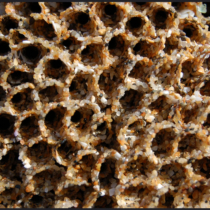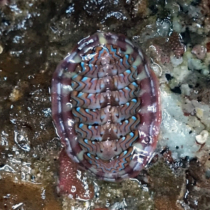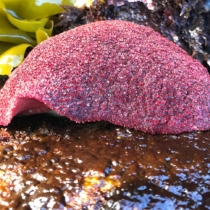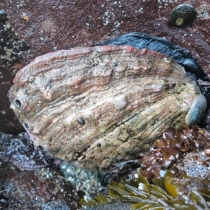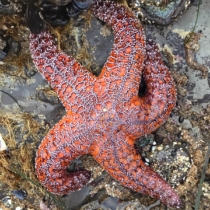
Oceanic inventory: Students count sea creatures in name of science
December 2013
Front page article of the Santa Cruz Sentinel – “On a Friday afternoon at Asilomar State Beach, the receding surf left a pool packed with life in each rocky hollow. Teenage scientists arrived in rubber boots, armed with clipboards and pencils, to inventory every creature. Their records would contribute to an invaluable archive of coastal life.” Article by Molly Sharlach reposted in San Jose Mercury News (December 14, 2013)
Students Help Track Massive Sea Star Die-Off
November 2013
Disease, in the form of a flesh-melting pathogen, is quickly wiping out entire sea star populations along the West Coast of the United States. Coined ‘sea star wasting disease’, localized reports of the disease began surfacing in Summer 2013. As reports continue to become more frequent and widespread, LiMPETS students have mobilized. This November, students are counting stars within permanent plots at our LiMPETS sites along the coast. Based on our student surveys, it appears that the disease has already decimated populations near Half Moon Bay and elsewhere. More broadly, our student efforts are helping to inform a centralized effort led by UC Santa Cruz to track the extent of the disease.
Get further information on the UC Santa Cruz Pacific Rocky Intertidal Monitoring Network website
Embracing a New Generation of Citizen Scientists
August 2013
For better or worse, LiMPETS has officially joined the blogosphere. Read the new citizen science blog on the OceanSpaces website. The blog, written by Amy Dean, highlights the unique successes of the LiMPETS program. Excerpt from the blog follows. Why engage teens in citizen science? They are a diverse, moody bunch. The field of citizen science is already flush with seasoned and reliable adult enthusiasts, birders, divers, nature photographers, and nature lovers.
LiMPETS Unveils Long-Term Monitoring Results to the State
April 2013
Ever wonder how LiMPETS data are used, if data reveal important trends, and how the program informs mangement and conservation efforts? This April, LiMPETS provided state agencies with analyses of the LiMPETS long-term data sets, collected by thousands of student citizen-scientists over a 10+ year period. The report focuses on ecological status and long-term trends along beaches and rocky intertidal areas within California’s North Central Coast region, including trends within California’s new network of marine protected areas. LiMPETS findings identify long-term declines in key species of the rocky intertidal. Additionally, initial benefits of protection may include greater stability of community composition over time.
Holey Moley! Sanctuary Beaches Experiencing Largest Mole Crab Baby Boom in 10+ Years
March 2013
Mole (sand) crabs are among the most important and abundant invertebrates on beaches within the LiMPETS network. Despite their significance, no long-term data set exists for this species – except for the Sanctuary’s LiMPETS sandy beach data set. This spring, beaches throughout the Gulf of the Farallones and Monterey Bay National Marine Sanctuary regions have been experiencing unusually high numbers of young crabs recruiting to the swash zones of our beaches. In particular, El Camino High School collected (and counted) 5,000 young mole crabs(within 100 core samples) on Pacific State Beach in late March. Since 2001, this may be the largest recruitment event in these Sanctuaries on record!
LiMPETS Student-scientists at AGU Conference
December 2012
Posters are a common way for scientists to communicate their research at conferences and meetings. LiMPETS students from the San Francisco Bay Area, including students and interns from the Branson School and the California Academy of Sciences, joined 22,000 scientists from around the world at the annual AGU meeting in San Francisco. Students received their badges and entered the enormous Moscone Center halls on December 5th to present their own posters. Students were excited and proud to talk to professional scientists about their research questions, analyses and conclusions drawn from hard work and years of data collection.
New LiMPETS Sites Along Central and South Coast
November 2012
With settlement funds from the Torch Platform Irene Oil Spill, the Channel Islands National Marine Sanctuary and LiMPETS has established three new rocky intertidal sites ranging from Pismo Beach to Los Angleles County: Shell Beach, Coal Oil Point (at left) and Point Fermin. LiMPETS training has been provided to 15 new teachers in Santa Barabara area counties to participate in monitoring these new sites.
Find out more about the Torch Rocky Intertidal Project and contact Jessie Altstatt to get involved.
New LiMPETS Site at Vandenberg Airforce Base
January 2012
In 1997, an undersea pipeline linking Platform Irene to shore ruptured, sending more than 160 barrels of oil into the waters near Vandenberg Airforce Base. Miles of shoreline were fouled. The Torch Trustee Council was formed to oversee and fund restoration efforts. Channel Islands National Marine Sanctuary was awarded funding, in part, to partner with Cabrillo High School in Vandenberg Village and establish a new LiMPETS monitoring site on base. In November 2011, members of the Cabrillo High Aquarium Club joined CINMS staff and the Torch trustees to visit the site and collect data. Our main goal is to reduce the impacts from human disturbance and preserve the intertidal through education.
New LiMPETS Curriculum Deepens Student Learning
January 2012
After a two year effort, the Farallones Marine Sanctuary Association has completed a 5-unit pilot curriculum for the LiMPETS Sandy Beach and Rocky Intertidal Programs. Evolved from a simple teacher handbook, this new curriculum is packed with scientific background materials and an array of classroom activities for grades 6 through 12. Evaluation of students who completed the LiMPETS program and classroom curricular materials showed improved scientific knowledge and increased awareness of ocean issues.
FREE California Tidepool App
January 2012
Next time you head to the tidepools, bring your iPhone or iPad (waterproof case recommended). A new California Tidepool App is now available to answer your burning questions about intertidal life like, why are chitons so cool? –and– how long can sea urchins live? Much like a field guide, the App has photos, fun facts, and more. It is a great tool for teachers, LiMPETS student-scientists, and anyone who is curious about tidepool life on the California coast. Created by the Channel Islands National Marine Sanctuary, UCSB Marine Science Institute, LiMPETS, and volunteers from Citrix Systems, Inc. Search for Tidepools in the Apple Store.




